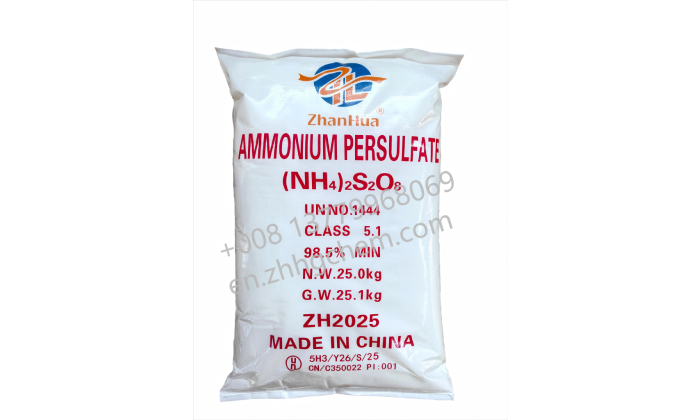In the oil extraction industry, ammonium persulfate capsule gel - breakers are commonly used chemicals, mainly applied in the hydraulic fracturing process. Their function is to promote the decomposition of colloids by releasing active substances, thereby enhancing the recovery efficiency of oil and gas resources. However, due to the presence of ammonia nitrogen and ammonium ions in ammonium persulfate, which have a relatively significant impact on the environment, it is necessary to strictly control its usage amount and release characteristics during the application process. To ensure that the performance of the gel - breaker meets the expected effect, it is essential to scientifically test its release rate. The following will provide a detailed introduction to a commonly used testing method for the release rate of ammonium persulfate capsule gel - breakers, helping readers better understand its operation process and application value.

I. Testing Principle and Significance
The testing of the release rate of ammonium persulfate capsule gel - breakers is mainly based on the principle of dissolution and release. Gel - breakers usually consist of ammonium persulfate and a capsule material. The capsule material will gradually dissolve under specific conditions, releasing the active ingredients inside. The core objective of the test is to simulate the actual usage environment and measure the release rate and total release amount of the gel - breaker under different conditions, thereby evaluating whether its performance meets the requirements.
During the oil extraction process, the fracturing fluid is usually in a high - temperature and high - pressure environment and is simultaneously affected by various chemical substances. To ensure that the gel - breaker can adapt to these complex conditions, the testing method needs to simulate the actual application environment as much as possible. For example, by adjusting the temperature, pressure, and solvent type, the performance of the gel - breaker under different conditions can be observed. This method can not only reflect the static release characteristics of the gel - breaker but also evaluate its stability in a dynamic environment.
First, an appropriate amount of ammonium persulfate capsule gel - breaker samples need to be prepared, ensuring that their quality and particle size meet the testing requirements. The uniformity and representativeness of the samples are the basis for the accuracy of the test results.
(2) Setting Experimental Conditions
According to the actual application requirements, appropriate temperature, pressure, and solvent type are set. For example, the fracturing process usually occurs under high - temperature and high - pressure conditions, so these conditions need to be simulated during the test. Meanwhile, a solvent that matches the actual application scenario is selected to ensure the reliability of the test results.
The samples are placed in a dynamic dissolution apparatus, and the release amount at different time points is recorded. By monitoring the change in the concentration of ammonium persulfate in the dissolution solution, the release curve of the gel - breaker can be plotted. This curve can visually reflect the release rate and total release amount of the gel - breaker.
Based on the test results, the average release rate and release time of the gel - breaker are calculated. By comparing the test data of different samples, products with better performance can be screened out. In addition, the impact of factors such as temperature and pressure on the release performance can be analyzed, providing a scientific basis for practical applications.
III. Application of Test Results
The test results of the release rate of ammonium persulfate capsule gel - breakers are not only of great significance in product research and development but also play a crucial role in practical applications. Firstly, the test data can be used to optimize the formula of the gel - breaker, such as adjusting the composition and thickness of the capsule material, thereby improving its release rate and stability. Secondly, the test results can also provide guidance for practical applications, such as selecting gel - breaker products suitable for specific environmental conditions to ensure their efficient application in oilfield extraction.
In the industry, Fujian Zhanhua Chemical is an enterprise specializing in persulfate products, and its products have been widely used in the oil extraction industry. Fujian Zhanhua Chemical ensures that the performance of its gel - breaker products meets customer requirements through strict quality control and scientific testing processes. For example, its ammonium persulfate capsule gel - breakers have undergone multiple release rate tests and can stably release in high - temperature and high - pressure environments, providing reliable technical support for oil extraction. In addition, Fujian Zhanhua Chemical also attaches great importance to the environmental performance of its products. Although ammonium persulfate itself has a certain impact on the environment, through optimizing the production process and improving product purity, it minimizes the impact on the environment as much as possible.
The testing method for the release rate of ammonium persulfate capsule gel - breakers is a scientific technical means that can help users accurately evaluate the performance of products and provide a reliable basis for practical applications. Through a scientific testing process, the formula of the gel - breaker can be optimized, improving its performance in complex environments. Choosing a reliable partner, such as Fujian Zhanhua Chemical, can not only ensure that the product performance meets expectations but also provide strong support for the development of enterprises.